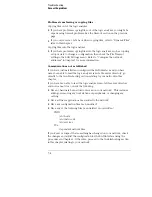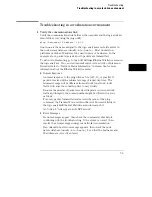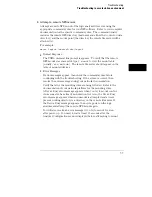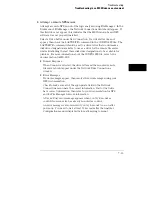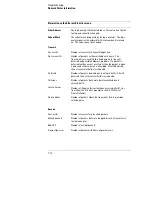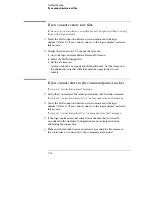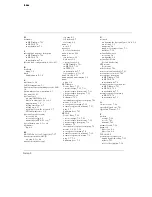
The following table describes each bit in the status number.
Status Bits
Bit 0
The internal registers of the LAN IC are loaded with known test values and
then are read. If this bit is not set, it implies that the LAN IC is operating
properly and that the microprocessor can communicate with the LAN IC.
If this bit is set, then the LAN module is not operational and must be
replaced.
Bit 1
The CAM (Content Addressable Memory) bit reports whether the LAN
address can be written from the LAN module Static RAM (SRAM) to the
internal memory of the LAN IC. Also, the CAM bit reports whether the LAN
address can be written to SRAM from the LAN IC. If this bit is not set, it
implies that both the SRAM and the LAN IC internal memory are able to
recognize and store the LAN address. If this bit is set, then the LAN
module is not operational and must be replaced.
Bit 2
If this bit is not set, then the self-test has detected that the LAN cable is
properly connected to the LAN board. If this bit is set, then the physical
connection of the LAN cable must be checked.
Bit 3
If the Termination bit is set, then the self-test has detected an excessive
number of collisions. The most probable cause of excessive collisions is
an improperly terminated LAN cable. Provide a proper termination of the
LAN cable according to the LAN topology being used.
Bit 4
The MAC (Media Access Control) bit indicates whether the Media Access
Control unit on the LAN IC is functioning. If this bit is not set, it implies that
both the transmit functions and receive functions of the LAN IC are
operating properly. If this bit is set, then the LAN module is not able to
properly transmit and receive packets and must be replaced.
Bit 5
The ENDEC (Encoder/Decoder) bit indicates whether the encoder/decoder
internal to the LAN IC is functioning. The encoder/decoder is the interface
between the MAC and the Ethernet transceiver. If this bit is set, then the
ENDEC is not operating properly and the LAN module must be replaced.
Troubleshooting
Status Number
7–17
Summary of Contents for 1660 CS Series
Page 7: ...1 Connecting and Configuring...
Page 16: ...1 10...
Page 17: ...2 Accessing the Logic Analyzer File System...
Page 25: ...3 Using the X Window Interface...
Page 37: ...4 Retrieving and Restoring Data...
Page 50: ...4 14...
Page 51: ...5 Programming the Logic Analyzer...
Page 64: ...5 14...
Page 65: ...6 Concepts...
Page 72: ...6 8...
Page 73: ...7 Troubleshooting...
Page 104: ...Index Index 4...


